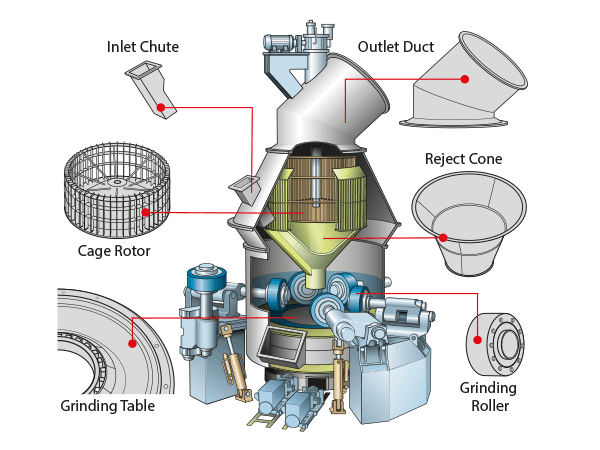Lithium ion battery graphite anode material vertical roller mill
Mill machine manufacturer SBM heavy machine provides lithium ion battery graphite anode material with microcrystalline graphite and flake graphite powder graphite mill vertical roller mill grinding machine, is a professional graphite powder production line equipment supplier, mill unit unit production 9-600t/h, powdered 100~325 mesh. SBM heavy machine grinding machine vertical roller mill grinding machine products are stable, energy-saving, environmentally friendly, and are favored by all graphite and manufacturers. SBM heavy machine Vertical Roller Mill can be equipped with different dust collecting and packaging equipment according to the special needs of materials or users.
First, comprehensive interpretation of lithium ion battery graphite anode material
Lithium-ion battery, also known as rocking chair battery, is mainly composed of a positive electrode, a negative electrode, a separator and an electrolyte. At present, the positive electrode of a lithium ion power battery generally adopts a spinel type LiMn2O4 or a nickel-based layered oxide, and the negative electrode is mainly graphite, and the electrolyte is an organic solution of a carbonate (EC, EMC) containing LiPF6. LiMn2O4 is a material that is considered safe and an inexpensive cathode material that has been used in many types of power batteries. Li(NiCo)O2 has high capacity, but its safety performance is poor. It needs to be modified by doping and its voltage is used to improve its safety performance. LiFePO4 is safe from the perspective of vehicle safety and battery cost. Long life is a positive electrode material for lithium ion batteries suitable for use in automotive power batteries.

The energy density of lithium-ion batteries depends to a large extent on the anode material. From the commercialization of lithium-ion batteries to the present, the anode materials used are mature, and the carbon materials are widely used, and the main one is still graphite. Graphite has a six-membered ring carbon network layered structure, and the carbon and carbon are SP2 hybrid, and the layers are connected by molecular force. There are two different crystal structures in graphite: hexahedral graphite (2H) and rhombohedral graphite (3R). The 2H phase has ABABA characteristic packing, and the 3R phase packing structure is ABCABC. The two phases can be transformed with each other. The 2H phase is thermodynamically stable and is more abundant in graphite, accounting for about four-fifths of the total. In the anode material of lithium ion batteries, natural graphite and artificial graphite have always used large negative electrode materials, but artificial Because graphite requires high temperature treatment in the production process, its production cost is greatly increased and the environment is adversely affected. Compared with artificial graphite, natural graphite has many advantages, its low cost, high degree of crystallization, purification, crushing and grading. The technology is mature, the charging and discharging voltage platform is low, and the theoretical specific capacity is high. These have laid a good foundation for its application in the lithium ion battery industry.
Natural graphite is divided into amorphous graphite (earth graphite or microcrystalline graphite) and flake graphite. The theoretical capacity is 372 mAh/g. Amorphous graphite has a low purity and a graphite interplanar spacing (d002) of 0.336 nm. Mainly 2H crystal plane sorting structure, that is, the graphite layer is arranged in the order of ABAB..., the orientation between the single crystallites is anisotropic, but after processing, the microcrystalline particles have a certain interaction with each other to form a block or particle. Shaped particles have isotropic properties. And the formed massive particles are easily pulverized into particles having a better shape.
In the process of lithium ion intercalation and deintercalation, the volume change is small and the structure is relatively stable, but the reversible specific capacity is only 260 mAh/g, and the irreversible specific capacity is above 100 mAh/g. The flake graphite has a high degree of crystallinity, and the sheet structure is unitized and has a remarkable anisotropy. This structure determines the large change in volume of graphite during lithium intercalation and deintercalation, resulting in destruction of the graphite layer structure, resulting in large irreversible capacity loss and severe deterioration of cycle performance. As a negative electrode graphite for lithium ion batteries, microcrystalline graphite and flake graphite have the disadvantages of large irreversible capacity for the first time, and the scale graphite has poor cycle performance and high current charge and discharge performance. Therefore, when used, researchers tend to focus on natural stone. The ink is modified to improve its own structural defects and improve the performance of the battery.
Second, graphite, petroleum coke milling process
(1) SBM heavy machine vertical roller mill grinding machine petroleum coke milling process
Scale graphite, petroleum coke milling process
The first stage: scale graphite, petroleum coke broken
The large piece of petroleum coke is transported to the raw material warehouse by a special vehicle, and then the material is sent to the jaw crusher by the forklift/manually for crushing, and the crushing is smaller than the larger feed size (15-30mm) of the vertical roller mill.
Second stage: flake graphite feedstock
The crushed graphite and the petroleum coke after the oil coke are lifted from the hoist to the storage hopper, and the storage hopper is blanked out and fed by the feeder evenly to the main machine.
The third stage: grinding machine grinding
After graphite and petroleum coke enter the vertical roller mill and grinder, the products that have passed the grinding are screened by the screening system and then enter the collector through the pipeline. After the collection, the graphite and petroleum coke fine powder are discharged through the discharge valve, which is the finished product. The powder falls into the main body of the vertical roller mill and is regrind.
The fourth stage: finished product collection
The flake graphite and the body are connected to the pulse dust collector through the ventilation pipe connected to the mill. The graphite and the body enter the powder collector and wait for packaging. The airflow purified by pulse dust collection flows into the blower through the residual air duct above the dust collector, and the air path is circulated. Except that the blower is positive pressure to the grinding chamber, the airflow in the other pipelines flows under negative pressure, and the indoor sanitary condition better.
